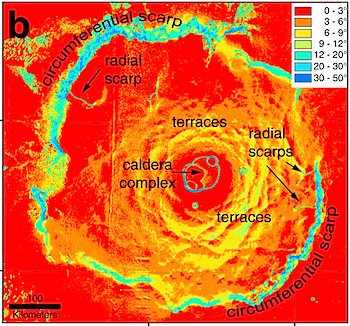 Scientists from the Division of Planetary Sciences and Remote Sensing in the Institute of Geological Sciences at Freie Universität Berlin have succeeded in creating a model simulating the formation of mysterious structures on the surface of the Mars volcano, Olympus Mons. The study was conducted in collaboration with the German Research Centre for Geosciences in Potsdam and Arizona State University.
Scientists from the Division of Planetary Sciences and Remote Sensing in the Institute of Geological Sciences at Freie Universität Berlin have succeeded in creating a model simulating the formation of mysterious structures on the surface of the Mars volcano, Olympus Mons. The study was conducted in collaboration with the German Research Centre for Geosciences in Potsdam and Arizona State University.
The findings were published in the latest issue of the international scientific journal, Journal of Geophysical Research – Planets.
The research project is based on image data of the High Resolution Stereo Camera (HRSC) that is installed on the European Mars Express spacecraft, which has been orbiting the red planet since December 2003. Using the camera images, the scientists in the Planetary Sciences and Remote Sensing group generated a mosaic and a terrain model of the Olympus Mons volcano. The image data show that the volcano shield is shaped in the form of arched terraces and the foot of the otherwise very flat volcano drops steeply. The origin of the terraces and the steep slope of Olympus Mons were discussed heatedly in previous publications. This study indicates that the observed deformations of the volcano are due to gravity, which on Mars is about 40 percent of the Earth’s gravity, and to low frictional resistance in the volcano subsurface. [More at links]








